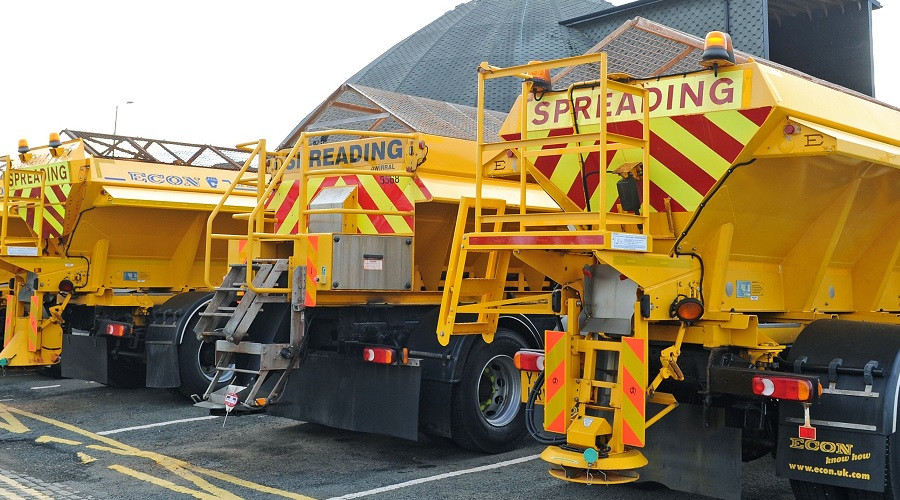Gritting crews prepare for the start of the winter season
Residents may see some of Wirral’s gritting fleet out and about on the roads this weekend, Saturday 4 November, even though there is no expectation of icy or frost weather conditions.
That’s because the crews will be carrying out their annual ‘dry run’ of the routes that will be treated this winter whenever weather conditions dictate that they need to be deployed.
This is part of the annual training that all staff engaged in the winter service plan take part in to prepare for the valuable role they will play to try and keep Wirral moving during the coldest part of the year.
As with every winter, Wirral Council will have crews on standby 24 hours a day, seven days a week between November and April, ready to take to the main roads to spread rock salt in order to minimise any impact there might be from ice or snow forming on the road surface - potentially putting people in danger or wreaking havoc on traffic.
They are called into action whenever detailed forecasts - provided under contract by Vaisala UK and MetDesk - show that road surface temperatures may drop to a level that means ice could form on road surfaces.
With more than 730 miles of public highway in Wirral, it simply isn’t possible to grit every one of them, so priority is given to 265 miles of well-used major roads and bus routes.
Wirral’s fleet of gritters spreads around 1,900 tonnes of salt in an average winter along 10 pre-planned routes. Each round normally takes three to five hours to complete and - when called into action – the first gritter should be on the road within an hour.
Roads which are prioritised for treatment are:
- main roads with a lot of traffic
- roads servicing emergency facilities such as hospitals, ambulance services, fire and rescue and police services
- public transport routes and access to stations, bus garages and depots
- roads servicing main industrial and business centres
- known problem areas, for example, significant hills and exposed areas
For more information on our winter maintenance programme, and to see a map of our gritting routes, visit the council's website.

Gritting by numbers
- Wirral’s fleet consists of 11 full size (18 tonne) gritters plus one spare and one mini (3.5 tonne) gritters which are used for day to day gritting operations, with snow ploughs available for each of the main gritters. The larger vehicles are deployed on the principal network and other main routes with the smaller vehicles being used on routes where access is restricted through vehicle parking and on steep hills and on bridges with weight restrictions. The fleet is ‘garaged’ at the Cleveland Street transport depot where it is maintained by the Transport Division fleet maintenance staff.
- There is currently 2,000 tonnes of rocksalt under covered storage at the Council’s salt dome storage at Cleveland Street transport depot and this will be replenished whenever necessary.
- The average winter season requires 38 treatments using 50 tonnes of rocksalt per treatment at the minimum spread rate of 10g/m2. That means on average 1,900 tonnes of rocksalt will be used.
- However, for certain forecasted weather conditions such as for example ice, freezing rain, sleet and prolonged snowfall and freezing conditions it may be necessary to increase spread rates up to a maximum of 40g/m2, in these instances individual treatment tonnages can be as much as 200 tonnes. Usage is monitored throughout the season to ensure stocks are maintained above 1,500 tonnes at any time.
- Around 42 tonnes of rock-salt will be used to fill and refill 100 grit bins in the borough. These are provided at locations where there is a need to undertake regular spot salting on roads or footpaths and may be placed at strategic locations on the network where there is a high pedestrian usage.
- The length of the Council’s highway network is 1180km (733 miles) and approximately 427km (265 miles) are treated as part of a routine pre-grit operation.
'Grit bits' you may not know...
- Roads are gritted when the road surface temperature demands it in an effort to stop ice forming on the road surface.
- Motorists are still advised to drive carefully - just because a road has been gritted does not mean the ice has gone.
- Rock salt needs vehicles to drive over it in order to work effectively. Vehicles grind the salt into smaller particles to spread it across the road.
- There may be occasions when it is not possible to grit roads, for example during rain - it just washes away the salt. If temperatures then drop suddenly, the wet roads may freeze before there is time to mobilise gritters.
- The gritting of motorways is carried out by National Highways, not local authorities.




